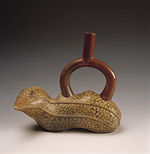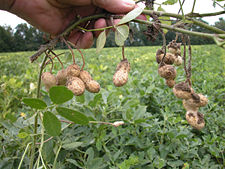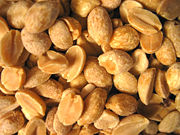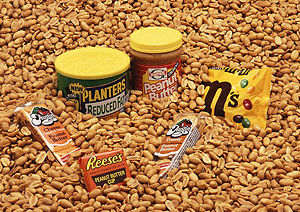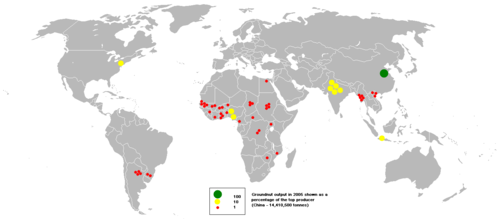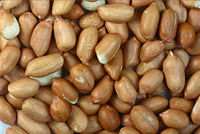Peanut
2008/9 Schools Wikipedia Selection. Related subjects: Food; Plants
| Peanut classification | ||||||||||||||||||
|---|---|---|---|---|---|---|---|---|---|---|---|---|---|---|---|---|---|---|
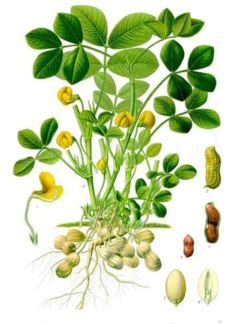 Peanut (Arachis hypogea)
|
||||||||||||||||||
| Scientific classification | ||||||||||||||||||
|
||||||||||||||||||
| Binomial name | ||||||||||||||||||
| Arachis hypogaea L. |
The peanut, or Groundnut (Arachis hypogaea), is a species in the legume family Fabaceae native to South America, Mexico and Central America. It is an annual herbaceous plant growing to 30 to 50 cm (1 to 1½ ft) tall. The leaves are opposite, pinnate with four leaflets (two opposite pairs; no terminal leaflet), each leaflet 1 to 7 cm (⅜ to 2¾ in) long and 1 to 3 cm (⅜ to 1 inch) broad. The flowers are a typical peaflower in shape, 2 to 4 cm (¾ to 1½ in) across, yellow with reddish veining. After pollination, the fruit develops into a legume 3 to 7 cm (1 to 2 in) long containing 1 to 4 seeds, which forces its way underground to mature.
The plant's name combines the morphemes pea and nut, causing some confusion as to the nature of the fruit. Although a nut in the culinary sense, in the botanical sense the fruit of the peanut plant is a woody, indehiscent legume and not a nut. The word pea describes the edible seeds of many other legumes in the Fabaceae family, and in that sense, a peanut is a kind of pea.
Peanuts are also known as earthnuts, goobers, goober peas, pindas, jack nuts, pinders, manila nuts and monkey nuts. (The last of these is often used to mean the entire pod)
History
The domesticated peanut is an amphidiploid or allotetraploid, meaning that it has two sets of chromosomes from two different species. The wild ancestors of the peanut were thought to be A. duranensis and A. ipaensis, a view recently confirmed by direct comparison of the peanut's chromosomes with those of several putative ancestors. This domestication might have taken place in Argentina or Bolivia, where the wildest strains grow today. In fact, many pre-Columbian cultures, such as the Moche, depicted peanuts in their art. .
Evidence demonstrates that peanuts were domesticated in prehistoric times in Peru. Archeologists have thus far dated the oldest specimens to about 7,600 years before the present. Cultivation spread as far as Mesoamerica where the Spanish conquistadors found the tlalcacahuatl (Nahuatl="cacao", whence Mexican Spanish, cacahuate and French, cacahuète) being offered for sale in the marketplace of Tenochtitlan (Mexico City). The plant was later spread worldwide by European traders. Cultivation in the English colonies of North America was popularized by African Americans, who brought the Kikongo word "goober".
The nut gained Western popularity when it came to the United States from Africa. It had become popular in Africa after being brought there from Brazil by the Portuguese around 1800.
Cultivation
The flower of the Arachis hypogaea is borne above ground and after it withers, the stalk elongates, bends down, and forces the ovary underground. When the seed is mature, the seed coat (mesocarp) changes colour from white to a reddish brown. The entire plant, including most of the roots, is removed from the soil during harvesting.
The pods begin in the orange veined, yellow petaled, pea-like flowers, which are borne in auxiliary clusters above ground. Following self-pollination, the flowers fade. The stalk at the base of the ovary, called the pedicel, elongates rapidly, and turns downward to bury the fruits several inches in the ground to complete their development.
The pods act in nutrient absorption. The fruits have wrinkled shells that are constricted between the two to three seeds. The mature seeds resemble other legume seeds, such as beans, but they have paper-thin seed coats, as opposed to the usual, hard legume seed coats.
Peanuts grow best in light, sandy loam soil. They require five months of warm weather, and an annual rainfall of 500 to 1000 mm (20 to 40 in) or the equivalent in irrigation water.
The pods ripen 120 to 150 days after the seeds are planted. If the crop is harvested too early, the pods will be unripe. If they are harvested late, the pods will snap off at the stalk, and will remain in the soil.
Peanuts are particularly susceptible to contamination during growth and storage. Poor storage of peanuts can lead to an infection by the mold fungus Aspergillus flavus, releasing the toxic substance aflatoxin. The aflatoxin producing molds exist throughout the peanut growing areas and may produce aflatoxin in peanuts when conditions are favorable to fungal growth.
Harvesting peanuts occurs in two stages. First a machine is used to cut off the main root of the peanut plant by cutting through the soil just below the level of the peanut pods. Then the same machine lifts the "bush" from the ground and shakes it. Then the machine inverts the bush to leave the plant upside down on the ground to keep the peanuts out of the dirt. This allows the peanuts to slowly dry to a bit less than a third of their original moisture level over a period of 2-3 weeks while they are left upside down on the field.
After the peanuts have dried sufficiently, they will then be threshed. This removes the peanut pods from the rest of the bush.
Cultivation in China
The peanut was introduced to China by Portuguese traders in the 1600s and another variety by American missionaries in the 1800s. They became popular and are featured in many Chinese dishes, often being boiled. During the 1980s peanut production began to increase greatly so that as of 2006 China was the world's largest peanut producer. A major factor in this increase has been China's move away from a communist economic system toward a free market system so that farmers are free to grow and market their crops as they decide.
Cultivars
Thousands of peanut cultivars are grown, with four major Cultivar Groups being the most popular: Spanish, Runner, Virginia, and Valencia. There are also Tennessee Red and Tennessee White groups. Certain Cultivar Groups are preferred for particular uses because of differences in flavor, oil content, size, shape, and disease resistance. For many uses the different cultivars are interchangeable. Most peanuts marketed in the shell are of the Virginia type, along with some Valencias selected for large size and the attractive appearance of the shell. Spanish peanuts are used mostly for peanut candy, salted nuts, and peanut butter. Most Runners are used to make peanut butter.
The various types are distinguished by branching habit and branch length. There are numerous varieties of each type of peanut. There are two main growth forms, bunch and runner. Bunch types grow upright, while runner types grow near the ground.
Each year new cultivars of peanuts are bred and introduced somewhere in the peanut belt of the U.S. or in other countries. Introducing a new cultivar may mean change in the planting rate, adjusting the planter, harvester, dryer, cleaner, sheller, and method of marketing.
Spanish group
The small Spanish types are grown in South Africa, and in the southwestern and southeastern U.S. Prior to 1940, 90% of the peanuts grown in Georgia were Spanish types, but the trend since then has been larger seeded, higher yielding, more disease resistant cultivars. Spanish peanuts have a higher oil content than other types of peanuts and in the U.S. are now primarily grown in Oklahoma and Texas.
Cultivars of the Spanish group include 'Dixie Spanish', 'Improved Spanish 2B', 'GFA Spanish', 'Argentine', 'Spantex', 'Spanette', 'Shaffers Spanish', 'Natal Common (Spanish)', 'White Kernel Varieties', 'Starr', 'Comet', 'Florispan', 'Spanhoma', 'Spancross', 'OLin', 'Tamspan 90', 'Spanco' 'Wilco I', 'GG 2', 'GG 4' and 'TMV 2'.
Runner group
Since 1940, there has been a shift to production of Runner group peanuts in the southeastern U.S. Runners are found in Georgia, Alabama, Florida, and South Carolina. This shift is due to good flavor, better roasting characteristics and higher yields when compared to Spanish types leading to food manufacturers' preference for use in peanut butter and salting.
Cultivars of Runners include 'Southeastern Runner 56-15', 'Dixie Runner', 'Early Runner', 'Virginia Bunch 67', 'Bradford Runner', 'Egyptian Giant' (also known as 'Virginia Bunch' and 'Giant'), 'Rhodesian Spanish Bunch' (Valencia and Virginia Bunch), 'North Carolina Runner 56-15', 'Georgia Green', 'Flavor Runner 458', 'Tamrun OL01', 'Tamrun OL02' and 'AT-108'.
Virginia group
The large seeded Virginia Group peanuts are grown in Virginia, North Carolina, Tennessee, and parts of Georgia. They are increasing in popularity due to demand for large peanuts for processing, particularly for salting, confections, and roasting in the shells.
Virginia Group peanuts are either bunch or running in growth habit. The bunch type is upright to spreading. It attains a height of 45 to 55 cm (18 to 22 inches), and a spread of 70 to 80 cm (28 to 30 in), with 80 to 90 cm (33 to 36 in) rows that seldom cover the ground. The pods are borne within 5 to 10 cm of the base of the plant.
Cultivars of Virginia type peanuts include NC 7, NC 9, NC 10C, NC-V 11, VA 93B, NC 12C, VA-C 92R, Gregory, VA 98R, Perry, Wilson, Hull, VC-2 and Shulamit
Valencia group
Valencia Group peanuts are coarse, and they have heavy reddish stems and large foliage. In the U.S. large commercial production is primarily in Eastern New Mexico, especially in and around Portales, New Mexico, but they are grown on a small scale elsewhere in the South as the best flavored and preferred type for boiled peanuts. They are comparatively tall, having a height of 125 cm (50 inches) and a spread of 75 cm (30 inches). Peanut pods are borne on pegs arising from the main stem and the side branches. Most of the pods are clustered around the base of the plant, and only a few are found several inches away. Valencia types are three seeded and smooth, with no constriction between the seeds. Seeds are oval and tightly crowded into the pods. There are two strains, one with flesh and the other with red seeds. Typical seed weight is 0.4 to 0.5 g.
Tennessee Red and Tennessee White groups
These are alike, except for the colour of the seed. The plants are similar to Valencia types, except that the stems are green to greenish brown, and the pods are rough, irregular, and have a smaller proportion of kernels.
Uses
Edible peanuts account for two-thirds of the total peanut use in the United States. Popular confections include salted peanuts, peanut butter ( sandwiches, candy bars, and cups), peanut brittle, and shelled nuts (plain/roasted). Salted peanuts are usually roasted in oil and packed in retail size, plastic bags or hermetically sealed cans. Dry roasted, salted peanuts are also marketed in significant quantities. The primary use of peanut butter is in the home, but large quantities are also used in the commercial manufacture of sandwiches, candy, and bakery products. Boiled peanuts are a preparation of raw, unshelled green peanuts boiled in brine and typically eaten as a snack in the southern United States where most peanuts are grown. More recently, peanuts can be fried, where they can be eaten both shell and nut.
Peanuts are common ingredients in Peruvian Creole cuisine reflecting the marriage of native ingredients and ingredients introduced by Europeans. In one example peanuts are roasted along with hot peppers (both native to South America) and blended with roasted onions, garlic, and oil (all of European origin) to make a smooth sauce poured over boiled potatoes. This dish is especially famous in the city of Arequipa and is known as "papas con ocopa". Another example combines a similar mixture with sautéed seafood or boiled and shredded chicken in the form of a fricassee. These dishes are generally known as "Ajis" such as "Aji de Pollo" "Aji de Mariscos". One may find that not all cooks use peanuts in seafood "ajis". The combination of ground roasted peanuts suggests some Moorish and Middle Eastern influence in modern Peruvian cuisine, presumably through the Spanish conquistadores. It is well documented that Middle Eastern cuisine makes extensive use of ground and pastes of almonds, pine nuts and other nuts combined with rice, meats and vegetables to arrive to dishes like Rice Pilaf. In the Levantine and Catalan cuisine there is also a wide use of ground nuts. Although the peanut is not a nut it may be argued that the Spanish used the peanut along with local Peruvian ingredients to emulate their ancestral cuisine in the absence of almonds and pine nuts. Peanuts are also widely used in South-East Asian cuisine, particularly Indonesia, where it is typically made into a spicy sauce. Peanuts originally came to Indonesia from the Philippines, where the legume came from Mexico in times of Spanish colonization.
Common Indonesian peanut-based dishes include gado-gado, pecel, karedok and ketoprak, all vegetable salads mixed with peanut sauce, and the peanut-based dipping sauce for satay. Boiled peanuts are a popular Chinese snack and appetizer. Peanuts are also used in the Mali meat stew maafe.
Peanut oil is often used in cooking, because it has a mild flavor and burns at a relatively high temperature. Under the name Plumpy'nut 100 g (3.5 ounces), two small bags per day are given by the World Health Organization as a surviving base to many children in Africa. Peanuts are often a major ingredient in mixed nuts because of their inexpensiveness compared to Brazil nuts, cashews, walnuts, and so on. The U.S. airline industry used to be a relatively large purchaser of peanuts for serving during flights (6 million lb / 3 million kg annually) before the nuts were removed from flights by many airlines (largely due to allergy concerns, but also due to cost).
Peanuts are also very widely sold for garden bird feeding. Low grade or culled peanuts not suitable for the edible market are used in the production of peanut oil, seed and feed, although some owners of pet hookbills avoid these kinds for that reason.
Peanuts have a variety of industrial end uses. Paint, varnish, lubricating oil, leather dressings, furniture polish, insecticides, and nitroglycerin are made from peanut oil. Soap is made from saponified oil, and many cosmetics contain peanut oil and its derivatives. The protein portion of the oil is used in the manufacture of some textile fibers.
Peanut shells are put to use in the manufacture of plastic, wallboard, abrasives, and fuel. They are also used to make cellulose (used in rayon and paper) and mucilage (glue).
Peanut plant tops are used to make hay. The protein cake (oilcake meal) residue from oil processing is used as an animal feed and as a soil fertilizer.
Peanuts can also be used like other legumes and grains to make a lactose-free milk-like beverage, Peanut milk
Nutritional value
| Peanut, valencia, raw Nutritional value per 100 g (3.5 oz) |
|||||||||||||||||||||||||||||||||||||
|---|---|---|---|---|---|---|---|---|---|---|---|---|---|---|---|---|---|---|---|---|---|---|---|---|---|---|---|---|---|---|---|---|---|---|---|---|---|
| Energy 570 kcal 2390 kJ | |||||||||||||||||||||||||||||||||||||
|
|||||||||||||||||||||||||||||||||||||
| Percentages are relative to US recommendations for adults. Source: USDA Nutrient database |
|||||||||||||||||||||||||||||||||||||
Health benefits
Peanuts are a rich source of protein (roughly 30 grams per cup after roasting). Prior to 1990 the PER method of protein evaluation considered peanut protein along with soy protein an incomplete protein, containing relatively low amounts of the essential amino acids, cystine, and methionine (but high in lysine), and it was advised to be sure that a diet or meal with peanuts as a staple also include complementary foods such as whole grains like corn and wheat, which are adequate in methionine but limited by lysine. Protein combining has been largely discredited. Since 1990 the gold standard for measuring protein quality is the Protein Digestibility Corrected Amino Acid Score (PDCAAS) and by this criterion peanut protein and other legume proteins such as soy protein is the nutritional equivalent of meat and eggs for human growth and health.. An example of an extremely nutritious peanut-based food to restore health in starving-malnourished children is Plumpy'nut.
Peanut oil is a mainly monounsaturated fat, much of which is oleic acid, the healthful type of fat that has been implicated for skin health. Some say peanuts are an unbalanced source of fat because they have only trace amounts of required Omega-3 fats. Some brands of peanut butter are fortified with Omega-3 in the form of flaxseed oil to balance the ratio of Omega-3 to Omega-6.
Niacin
Peanuts are a good source of niacin and thus contribute to brain health, brain circulation and blood flow.
Peanuts and antioxidants
Recent research on peanuts and nuts in general has found antioxidants and other chemicals that may provide health benefits. New research shows peanuts rival the antioxidant content of many fruits. Roasted peanuts rival the antioxidant content of blackberries and strawberries, and are far richer in antioxidants than apples, carrots or beets. Research conducted by a team of University of Florida scientists, published in the journal Food Chemistry, shows that peanuts contain high concentrations of antioxidant polyphenols, primarily a compound called p-coumaric acid, and that roasting can increase peanuts' p-coumaric acid levels, boosting their overall antioxidant content by as much as 22%.
Peanuts and coenzyme Q10
Peanuts are a source of Coenzyme Q10 along with oily fish, beef, soybeans and spinach. Peanuts also help to accelerate the growth of male and female hormones.
Health concerns
Allergies
Although many people enjoy foods made with peanuts, some people have mild to severe allergic reactions. For people with peanut allergy, exposure can cause fatal anaphylactic shock. For these individuals, eating a single peanut or just breathing the dust from peanuts can cause a fatal reaction. An allergic reaction also can be triggered by eating foods that have been processed with machines that have previously processed peanuts, making the avoidance of such foods difficult.
A theory of the development of peanut allergy has to do with the way that peanuts are processed in North America versus other countries like China and India. Peanuts are widely eaten in China and India but peanut allergies are almost unheard of there. According to a 2003 study, roasting peanuts, as more commonly done in North America, causes the major peanut allergen Ara h2 to become a stronger inhibitor of the digestive enzyme trypsin, making it more resistant to digestion. Additionally, this allergen has also been shown to protect Ara h1, another major peanut allergen, from digestion - a characteristic further enhanced by roasting.
Though the allergy can last a lifetime, another 2003 study indicates that 23.3% of children will outgrow a peanut allergy.
Peanut allergy has been associated with the use of skin preparations containing peanut oil among children, but the evidence is not regarded as conclusive. Peanut allergies have also been associated with family history and intake of soy products.
Some school districts have banned peanuts, and there is now an experimental drug being tested to combat this allergy, called TNX-901.
As the peanut is a member of the legume family and is unrelated to nuts, individuals with peanut allergies may not be allergic to nuts, and vice-versa.
Some people mistakenly believe that peanut oil will not trigger allergies in peanut-allergic people. However, crude (unrefined) peanut oils are strongly flavoured, and have been shown to contain protein, which may cause allergic reactions.
In a randomised, double-blind, crossover study, 60 people with proven peanut allergy were challenged with both crude peanut oil and refined peanut oil. The authors conclude that “Crude peanut oil caused allergic reactions in 10% of allergic subjects studied and should continue to be avoided.” They also state that, “Refined peanut oil does not seem to pose a risk to most people with peanut allergy.” However, they point out that refined peanut oil can still pose a risk to peanut-allergic individuals if oil that has previously been used to cook foods containing peanuts is reused.
Peanuts and Aflatoxin
Peanuts may be contaminated with the mold Aspergillus flavus which produces a carcinogenic substance called aflatoxin. While this substance quickly causes liver cancer in rats, humans are far more resistant. Lower quality specimens, particularly where mold is evident, are more likely to be contaminated.
U.S. Department of Agriculture (USDA) program
George Washington Carver is often credited with inventing 300 different uses for peanuts(which, contrary to popular belief, did not include peanut butter but did include salted peanuts). Carver was one of many USDA researchers who encouraged cotton farmers in the South to grow peanuts instead of, or in addition to cotton, because cotton had depleted so much nitrogen from the soil, and one of the peanut's properties as a legume is to put nitrogen back into the soil (a process known as nitrogen fixation). Rising demand for peanuts in the early 1900s was not due to Carver's products but to a shortage of plant oils during World War I and the growing popularity of peanut butter, roasted peanuts and peanut candies. Peanut products originating around the early 1900s include many brands still sold today such as Cracker Jack (1893), Planters peanuts (1906), Oh Henry! candy bar (1920), Baby Ruth candy bar (1920), Butterfinger candy bar (1923), Mr. Goodbar candy bar (1925), Reese's Peanut Butter Cup (1925), Peter Pan (peanut butter) (1928) and Skippy peanut butter (1932).
Peanuts were designated by the U.S. Congress to be one of America's basic crops. In order to protect domestic industry by keeping prices artificially high, the United States Department of Agriculture (USDA) conducts a Program for Peanuts. Two USDA programs for domestic peanuts are the Price Support Program and the Production Adjustment Program (National Poundage Quota). The Price Support Program consists of a two-tier price support system that is tied to a maximum weight quota. Domestic peanuts produced subject to the weight quota are supported at the higher of two prices, while peanuts over quota or those produced on farms not having a quota are supported at the lower rate. The quota support price acts as a floor price for domestic edible peanuts. For producers who fail to fill their quota in any given year, there is a maximum 10% over marketing allowance for the subsequent year. Pursuant to the program, producers may place peanuts under nonrecourse loan with the Commodity Credit Corporation (CCC) at the designated support price or they may privately contract for the sale of their crop. This program was replaced by a market loan program similar to other commodities in 2002.
Trade

The major producers/exporters of peanuts are the United States, Argentina, Sudan, Senegal, and Brazil. These five countries account for 71% of total world exports. In recent years, the United States has been the leading exporter of peanuts. The major peanut importers are the European Union (EU), Canada, and Japan. These three areas account for 78% of the world's imports.
Although India and China are the world's largest producers of peanuts, they account for a small part of international trade because most of their production is consumed domestically as peanut oil. Exports of peanuts from India and China are equivalent to less than 4% of world trade.
Ninety percent of India's production is processed into peanut oil. Only a nominal amount of hand-picked select-grade peanuts are exported. India prohibits the importation of all oil seeds, including peanuts.
The European Union is the largest consuming region in the world that does not produce peanuts. All of its consumption is supplied by imports. Consumption of peanuts in the EU is primarily as food, mostly as roasted-in-shell peanuts and as shelled peanuts used in confectionery and bakery products.
The average annual U.S. imports of peanuts are less than 0.5% of U.S. consumption. Two thirds of U.S. imports are roasted, unshelled peanuts. The major suppliers are Taiwan, Malaysia, Hong Kong, Mainland China, and Canada. The principal suppliers of shelled peanut imports are Argentina and Canada. Most of Canada's peanut butter is processed from Chinese peanuts. Imports of peanut butter from Argentina are in the form of a paste and must be further processed in the U.S. Other minor suppliers of peanut butter include Malawi, China, India, and Singapore.
Approximately 50% of all peanuts produced in the United States are grown within a 160 km (100 mile) radius of Dothan, Alabama. Dothan is home to the National Peanut Festival established in 1938 and held each fall to honour peanut growers and celebrate the harvest.

